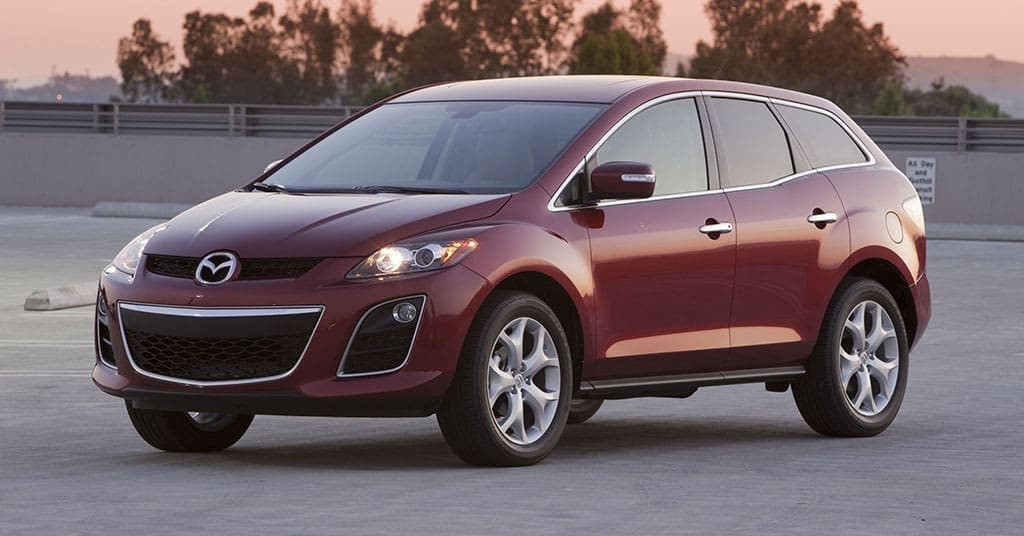Looking at a 2011 Mazda CX-7? Here’s what makes it fun, what can go wrong, and what to watch for
The 2011 Mazda CX-7 brought athletic styling and sharper handling to a compact SUV market often dominated by safe, conservative choices. Today, it remains a solid used option for buyers who put driving enjoyment ahead of ultimate practicality.
The CX-7 carried over largely unchanged from the previous model year and shared components with other Mazda vehicles such as the Mazda6 and MPV. It was sold in three basic trims: GX, GS and GT. It was eventually replaced by the more fuel-efficient Mazda CX-5 starting in 2013.
Two engine options were available: a 2.5-litre naturally aspirated four-cylinder producing 161 horsepower and 161 foot-pounds of torque, paired with a five-speed automatic transmission; and a 2.3-litre turbocharged four-cylinder delivering 244 horsepower and 258 foot-pounds of torque, mated to a six-speed automatic. While the non-turbo engine offers adequate performance and better fuel economy, the turbocharged version delivers noticeably stronger acceleration, but at the cost of significantly higher fuel consumption.
Transmissions: 5-speed auto (2.5L); 6-speed auto (2.3L Turbo)
Drivetrain: FWD standard; AWD available
Fuel economy (L/100 km): 10.4 city, 7.2 highway (2.5L); 12.2 city, 8.6 highway (2.3L Turbo)
Fuel type: Regular (2.5L); Premium (2.3L Turbo)
Seating capacity: 5
Cargo space: 1,658 litres
Original MSRP (Canada): Approx. $26,500 (GX base)
Safety ratings: Good (IIHS tests)
Fuel economy ratings for the non-turbo model were officially listed at 10.4 litres per 100 kilometres in city driving and 7.2 on the highway. Turbocharged models posted 12.2 and 8.6 litres per 100 kilometres respectively, and required premium fuel for optimal performance. With today’s fuel prices, the turbocharged CX-7’s need for premium gas may add noticeably to operating costs.
Even the base GX trim came well equipped, with 17-inch alloy wheels, air conditioning, rain-sensing wipers, heated mirrors, privacy glass, cruise control, keyless entry, a tilt-and-telescopic steering wheel with audio controls, and a CD/MP3 stereo. Higher trims added features such as leather upholstery, climate control, heated front seats, blind-spot monitoring, and 18- or 19-inch wheels.
However, the CX-7 was less flexible than some rivals. It seated five, but rear-seat legroom was tight for taller passengers. Cargo space with the rear seats folded totalled 1,658 litres—more than a Mitsubishi RVR but less than a Honda CR-V or Toyota RAV4 from the same era.
Crash safety ratings at the time were generally good, though the CX-7 did not earn top safety awards compared to some rivals.
Long-term maintenance considerations are essential for buyers to remember. Turbocharged models, in particular, are prone to turbo oil seal failures and timing chain stretch, both of which can lead to expensive repairs if neglected. Climate control system failures and noisy compressors have been reported, along with minor electrical issues such as headlight fogging, random airbag warning lights, and intermittent door lock problems. Rust, especially around the rear wheel wells and tailgate, is common on vehicles from regions with heavy road salt use. Suspension wear, including clunks and rattles over bumps, is also typical at higher mileages.
Parts availability remains good in Canada, and maintenance costs are moderate compared to European competitors. However, neglected maintenance is common among cheaper used examples, particularly on turbocharged models. You are strongly advised to obtain a pre-purchase inspection focusing on turbo health, timing chain condition, rust, and suspension integrity.
Prices for a used 2011 Mazda CX-7 in Canada typically range from about $3,000 to $5,000 for non-turbo GX models and $4,500 to $7,000 for turbocharged GS and GT models. Low-kilometre, well-maintained examples with full service history may command a premium, while rougher examples often sell for less but carry a higher risk of costly repairs. As the CX-7 ages, clean, rust-free examples are becoming harder to find, particularly in provinces with heavy road salt use.
Our Verdict
The 2011 Mazda CX-7 still holds some appeal for buyers looking for a sporty, affordable crossover with decent equipment and lively driving dynamics. However, its tight interior, relatively high fuel consumption, and advancing age make it less practical than newer options such as the second-generation Honda CR-V or Toyota RAV4.
If you find a well-maintained non-turbo model with documented service history, the CX-7 can still be a solid and enjoyable used buy. Caution is advised with higher-mileage turbocharged versions, where potential repair costs can outweigh any initial savings.
If driving enjoyment matters more than ultimate practicality, and the used 2011 Mazda CX-7 you are considering passes a thorough inspection, it’s still worth a look. Otherwise, more modern crossovers offer safer, roomier and more efficient alternatives.
Here’s what to check:
- Confirm full service history, especially regular oil changes and any timing chain repairs.
- Inspect carefully for rust around rear wheel wells, undercarriage and tailgate.
- Test drive to check for turbo boost hesitation or suspension clunks.
- Verify that the air conditioning blows cold and runs quietly.
- Confirm whether the vehicle requires premium fuel (turbo models) or runs on regular gas (non-turbo models).
Explore more on Mazda, 2011 used cars
The views, opinions, and positions expressed by our columnists and contributors are solely their own and do not necessarily reflect those of our publication.
Troy Media empowers Canadian community news outlets by providing independent, insightful analysis and commentary. Our mission is to support local media in helping Canadians stay informed and engaged by delivering reliable content that strengthens community connections and deepens understanding across the country.



